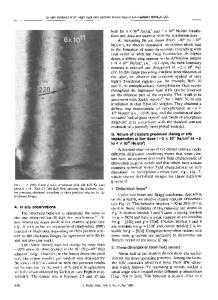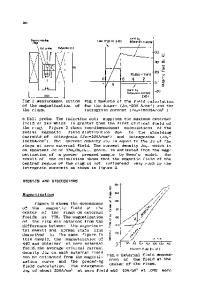Radiation Induced Amorphization in YBa 2 Cu 3 O 7 and GdBa 2 Cu 3 O 7 Superconductors
- PDF / 1,463,483 Bytes
- 5 Pages / 420.48 x 639 pts Page_size
- 6 Downloads / 370 Views
RADIATION INDUCED AMORPHIZATION IN YBa 2 Cu 3 O 7 AND CdBa 2 CU30 7 SUPERCONDUCTORS DON M. PARKIN* AND MICHAEL NASTASII*
*Center for Materials Science, Los Alamos National Laboratory. Los Alamos, NM 87545.
*•-Materials Science and Technology Division, Los Alamos National Laboratory, Los Alamos,
NM 87545
ABSTRACT The response of YBa 2 Cu3 0 7 and GdBa 2 Gu3 07 high temperature superBoth ion and electron conductors to particle irradiation is examined. irradiations have been shown to first produce an orthorhombic-to-tetragonal transformation at relatively low doses followed by a tetragonal-to-amorphous transformation at doses roughly a factor of 10 higher. Analysis of the displacement stoichiometry that results from 120, 300, and 1000 keV electron irradiations, 400, and 500 keV 0 irradiations, and 300 keV helium irradiations indicate that the orthorhombic-to-tetragonal transformation is driven by 0 atom displacements either alone or in the presence of metal atom displacements and that the transformation to the amorphous phase is driven by displacements on the Y, Gd or other rare earth atom site.
INTRODUCTION Investigations of the response of the ceramic high temperature superconductors have shown them to have a very rich, diverse and complicated 1 interaction with various radiation fields. One specific effect is that 2 3 after sufficient dose of 300 keV electrons, 1 MeV electrons, 300 keV He 4 5 6 ions, 400 keV 0 ions, and 500 keV 0 ions, an insulating amorphous phase is formed in YBa 2 Cu30 7 and after 1 MeV electron irradiation in CdBa2Cu. 3 0 7 . This observation has technological importance in electronic device applica6 tions where it can be used to form devices such as a SQUID. In a more fundamental context, however, amorphization can be used to study both the crystal stability of these materials as well as how they interact with radiation. In this paper we present a model of irradiation induced amorphization in YBa 2 Cu 3 O 7 and GdBa 2 Cu 3 0 7 . It is shown that the amorphization process consists of two transformations. First, displacement produced disorder on the 0 sublattice transforms the orthorhombic structure to tetragonal. After further irradiation when sufficient numbers of Y or Cd atoms have been displaced, the defected tetragonal phase transforms to the amorphous phase.
CASCADE STOICHIOMETRY The large mass difference among the 0, Cu, Ba, Y. and Gd atoms in the YBa 2 Cu 3 0 7 and CdBa 2 Cu 3 0 7 superconductors has a strong effect on how particle irradiation couples to the material and starts the damage process. Mitchell 7 et al. who irradiated YBa 2 Cu 3 0 7 and CdBa 2 Cu 3 0 7 with 120 keV electrons and 8 Kirk et al. who irradiated YBa 2 Cu 3 0 7 , with 131- and 152- keV electrons, both concluded that the displacement energy Ed was near 20 eV for 0 atoms. The maximum recoil energies of the metal atoms from direct electron colli7 sions are 6 eV or less. Further, the observation of twin boundary motion 8 is a direct indication of 0 displacement. Under low energy electron irradiation, the cascade
Data Loading...











